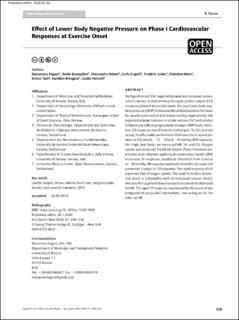| dc.contributor.author | Fagoni, Nazzareno | |
| dc.contributor.author | Bruseghini, Paolo | |
| dc.contributor.author | Adami, Alessandra | |
| dc.contributor.author | Capelli, Carlo | |
| dc.contributor.author | Lador, Frederic | |
| dc.contributor.author | Moia, Christian | |
| dc.contributor.author | Tam, Enrico | |
| dc.contributor.author | Bringard, Aurélien | |
| dc.contributor.author | Ferretti, Guido | |
| dc.date.accessioned | 2021-06-04T12:28:33Z | |
| dc.date.available | 2021-06-04T12:28:33Z | |
| dc.date.created | 2021-01-20T13:16:23Z | |
| dc.date.issued | 2020 | |
| dc.identifier.citation | International Journal of Sports Medicine. 2020, 41(4), 209-218. | en_US |
| dc.identifier.issn | 0172-4622 | |
| dc.identifier.uri | https://hdl.handle.net/11250/2757967 | |
| dc.description | This article is available under the Creative Commons CC-BY-NC-ND license and permits non-commercial use of the work as published, without adaptation or alteration provided the work is fully attributed. | en_US |
| dc.description.abstract | We hypothesised that vagal withdrawal and increased venous return interact in determining the rapid cardiac output (CO) response (phase I) at exercise onset. We used lower body negative pressure (LBNP) to increase blood distribution to the heart by muscle pump action and reduce resting vagal activity. We expected a larger increase in stroke volume (SV) and smaller for heart rate (HR) at progressively stronger LBNP levels, therefore CO response would remain unchanged. To this aim ten young, healthy males performed a 50 W exercise in supine position at 0 (Control), −15, −30 and −45 mmHg LBNP exposure. On single beat basis, we measured HR, SV, and CO. Oxygen uptake was measured breath-by-breath. Phase I response amplitudes were obtained applying an exponential model. LBNP increased SV response amplitude threefold from Control to −45 mmHg. HR response amplitude tended to decrease and prevented changes in CO response. The rapid response of CO explained that of oxygen uptake. The rapid SV kinetics at exercise onset is compatible with an increased venous return, whereas the vagal withdrawal conjecture cannot be dismissed for HR. The rapid CO response may indeed be the result of two independent yet parallel mechanisms, one acting on SV, the other on HR. | en_US |
| dc.language.iso | eng | en_US |
| dc.subject | cardiac output | en_US |
| dc.subject | heart rate | en_US |
| dc.subject | kinetics and exercise transient | en_US |
| dc.subject | LBNP | en_US |
| dc.subject | oxygen uptake | en_US |
| dc.subject | stroke volume | en_US |
| dc.title | Effect of lower body negative pressure on phase I cardiovascular responses at exercise onset | en_US |
| dc.type | Peer reviewed | en_US |
| dc.type | Journal article | en_US |
| dc.description.version | publishedVersion | en_US |
| dc.rights.holder | © Georg Thieme Verlag KG | en_US |
| dc.source.pagenumber | 209-218 | en_US |
| dc.source.volume | 41 | en_US |
| dc.source.journal | International Journal of Sports Medicine | en_US |
| dc.source.issue | 4 | en_US |
| dc.identifier.doi | 10.1055/a-1028-7496 | |
| dc.identifier.cristin | 1875491 | |
| dc.description.localcode | Institutt for fysisk prestasjonsevne / Department of Physical Performance | en_US |
| cristin.ispublished | true | |
| cristin.fulltext | original | |
| cristin.qualitycode | 1 | |
